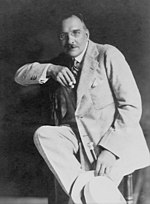Wilfrid Voynich
Wilfrid Voynich | |
|---|---|
Michał Habdank-Wojnicz | |
 Voynich in 1900 | |
| Born | 12 November 1865 |
| Died | 19 March 1930(aged 64) |
| Nationality | Polish |
| Occupation(s) | Revolutionary, antiquarian book dealer |
| Known for | Discovery of theVoynich manuscript |
| Spouses |
|
Wilfrid Voynich(bornMichał Habdank-Wojnicz;12 November [O.S.31 October] 1865[1]– 19 March 1930) was a Polish[2][3]revolutionary,antiquarianandbibliophile.Voynich operated one of the largest rare book businesses in the world.[4]He is remembered as theeponymof theVoynich manuscript.
Life
[edit]Michał Habdank-Wojnicz was born in the town ofTelšiaiin present-dayLithuania,then part of theRussian Empire,into aPolish-Lithuaniannoble family.[5]The "Habdank"part of his surname is the name of a Polishheraldic clan.He was the son of aPolishpetty official (titular counsellor).[1]
He attended agimnazjuminSuwałki(a town in northeasternPoland), then studied at theuniversity of Warsaw,St. Petersburg,and Moscow. He graduated fromMoscow Universityinchemistryand became alicensed pharmacist.[5]

In 1885, inWarsaw,Wojnicz joinedLudwik Waryński's revolutionary organization,Proletariat.In 1886, after a failed attempt to free fellow-conspiratorsPiotr Bardowski(1846–1886) andStanisław Kunicki(1861–1886), who had both been sentenced to death, from theWarsaw Citadel,he was arrested by the Russian police. In 1887, he was sent topenal servitudeatTunkanearIrkutskinSiberia.
Whilst in Siberia, Voynich acquired a working knowledge of eighteen different languages, albeit not well.[6][7]
In June 1890 he escaped fromSiberiaand travelling west by train got toHamburg,eventually arriving inLondonin October 1890.[8] Under the assumed name of Ivan Kel'chevskii at first, he worked withSergius Stepniak,a fellow revolutionary, under the banner of the anti-tsaristSociety of Friends of Russian Freedomin London.[9]After Stepniak's death in a railway crossing accident in 1895, Voynich ceased revolutionary activity.
Voynich became an antiquarian bookseller from around 1897, acting on the advice ofRichard Garnett,a curator at theBritish Museum.[10]Voynich opened a bookshop atSoho Squarein London in 1898. He was remarkably lucky in finding rare books, including aMalermiBible inItalyin 1902.[7]
In 1902 he married a fellow former revolutionary,Ethel Lilian Boole,daughter of the BritishmathematicianGeorge Boole,with whom Voynich had been associated since 1890. Voynich was naturalised as aBritish subjectand on 25 April 1904, taking the legal name Wilfrid Michael Voynich.
Voynich opened another bookshop in 1914 inNew York.With the onset of theFirst World War,Voynich was increasingly based inNew York.[11]He became deeply involved in the antiquarian book trade, and wrote a number of catalogues and other texts on the subject.
Voynich relocated his London bookshop to 175Piccadillyin 1917.[12]Also in 1917, based on rumours, Voynich was investigated by theFBI,in relation to his possession ofBacon's cipher.The report also noted that he dealt with manuscripts from the 13th, 12th, and 11th centuries, and that the value of his books at the time was half a million dollars. However, the investigation did not reveal anything significant beyond the fact that he possessed a secret code nearly amillenniumold.[4]
Voynich died atRoosevelt Hospitalin New York, in 1930, oflung cancer.[13]
Voynich manuscript
[edit]The most famous of Voynich's possessions was a mysteriousmanuscripthe said he acquired in 1912 at theVilla MondragoneinItaly,but first presented in public in 1915.[14]The book has beencarbon-dated,which revealed that the materials were manufactured sometime between 1404 and 1438.[15]He owned the manuscript until his death.
See also
[edit]References
[edit]- ^abДеятели революционного движения в России: Био-библиографический словарь: От предшественников декабристов до падения царизма: [В 5 т.]. - М.: Изд-во Всесоюзного общества политических каторжан и ссыльно-поселенцев, 1927-1934.Entry on VoynichArchived27 March 2020 at theWayback Machine
- ^"Wilfrid Voynich - The Voynich Manuscript".Wilfrid Voynich.Archived fromthe originalon 7 July 2019.Retrieved5 March2019.
- ^Katz, Brigit."Here's What You Need to Know About the Mysterious Voynich Manuscript".Smithsonian.Retrieved5 March2019.
- ^abColin MacKinnon (2013)."The U.S. Bureau of Information File On Wilfrid Voynich"(PDF).
- ^abRené Zandbergen (2017)."H. Wilfrid Michael Voynich".
- ^Symonds, John (1997)."Illustrations from the Wellcome Institute Library Wellcome and Osler".Medical History.41(2): 213–225.doi:10.1017/S0025727300062396.PMC1043907.PMID9156466.
- ^ab"Mr. W. M. Voynich." Times [London, England] 22 March 1930: 17. The Times Digital Archive. Web. 10 April 2017.
- ^Gerry Kennedy (28 April 2016).The Booles and the Hintons: Two Dynasties That Helped Shape the Modern World.Cork University Press.ISBN978-1-78205-185-5.
- ^Bernhardt, Lewis (Autumn 1966)."The Gadflyin Russia "(PDF).The Princeton University Library Chronicle.28(1): 2.doi:10.2307/26409690.JSTOR26409690.Archived fromthe original(PDF)on 5 October 2016.Retrieved3 February2010.
- ^The Library World Vol 34 Issue 9
- ^Duffy, Eamon (20 April 2017)."Secret Knowledge—or a Hoax?".The New York Review.Retrieved23 October2017.
- ^"The bookseller: a newspaper of British and foreign literature".London: [s.n.] 23 October 2017.Retrieved23 October2017– via Internet Archive.
- ^Colin MacKinnon (2013)."Wilfrid Michael Voynich's Certificate of Death And Grave Site"(PDF).Archived fromthe original(PDF)on 12 June 2015.Retrieved23 October2017.
- ^"Manuscripts Worth $1,000,000 Admired at Albright Art Gallery".The Buffalo Evening News.9 December 1915. p. 21.Retrieved4 April2020– via Newspapers.
- ^Goldman, Eleonora (20 April 2017)."Russian scholars unlock the secret of the mysterious Voynich manuscript".Retrieved25 August2018.
The manuscript is an illustrated medieval codex written by an unknown author between 1404 and 1438.
External links
[edit]- 1865 births
- 1930 deaths
- People from Telšiai
- People from Kovno Governorate
- Clan Abdank
- Revolutionaries from the Russian Empire
- Polish antiquarians
- Emigrants from the Russian Empire
- Immigrants to the United Kingdom
- Immigrants to the United States
- Polish book and manuscript collectors
- Polish male non-fiction writers
- Soho Square
- People from the Russian Empire of Polish descent
